Arts in Schools: Why it Matters
February 15, 2019
In February of 2018, President Trump announced his financial plan for 2019 that included major budget cuts for the National Endowment for the Arts–an independent federal organization responsible for funding and promoting arts education in the United States. After its establishment in 1965, the NEA became one of the three major sources of funding for the Arts in the United States. This proposal for the 2019 fiscal year was based upon the idea that the President would eventually shut down this federal organization, as he believed it was not a vital part of arts funding. Later in March, a bill was passed to increase NEA funding to nearly $3 million, a surprise for many after the proposed budget cuts.

Since then the proposal has gone through a multitude of changes, but has brought about many questions that still hold true, even when funding may not go directly to public schools: What is the real importance of the arts not only in our lives but in our schools?
What are “the Arts”?
When you think of “the arts,” what comes to mind at the surface may be painting, drawing, or what we might call the “visual arts.” But it is important to recognize that theatre, dance, drama, music, writing, are all equally a part of this definition. Whether you are drawing a sketch for a project, memorizing lines for a skit, or writing a story, chances are that you participate in the arts on a daily basis-whether you know it or not. And it will not surprise you to hear that participation in the arts on any level, has been psychologically proven to have major benefits on one’s mental and physical health.
The Real Benefits
A study by the Arts Education Partnership, produced in conjunction with the NEA, demonstrated that participation in the arts, ex. music, dance, drama, can increase academic achievement in subjects like math, reading, and writing. According to the study, theatre can help understand complex social relationships, dance can encourage creative thinking, and visual arts improve organizational skills and image reasoning.

Not only can the arts increase academic performance, but they have also been proven to increase graduation rates. In a 2009 report by the Centers for Arts Education, schools who gave students more opportunities to be involved in the arts and had more outlets for creativity saw a greater rate of graduation than those who did not have these opportunities.
In School Opportunities
Here at Franklin High School, we are lucky enough to have access to a multitude of artistic opportunities on a daily basis, whether in a class or extracurricular.
Students can take classes in:

- Art (Drawing/Painting, Portfolio Prep, Combined Arts, etc.),
- Ceramics and Sculpture
- Theatre Arts/Technical Theatre
- Band/Orchestra
- Chorus
- Piano, Guitar, Music Theory
- Graphic Design/Digital Journalism
- Creative Writing
On top of the wide variety of class selections, students also have the opportunity to participate in a variety of extracurricular activities, such as Drama Club, Empty Bowls, Select Chorus, Jazz Band, and much more.
Franklin Arts Academy
For those who are even more artistically inclined, the Franklin Arts Academy is a great part of our school’s offerings. This program offers students the opportunity to select courses with a focus on art and creative learning, as many find this style to be more suited for them. A student on this path may also opt to take a variety of arts courses on top of their regular scheduled academics.
FAA has a long history at Franklin High School. “FAA was started in 2010,” says current Franklin Arts Academy director Ms. Tebbetts. “In the first class, there were only around 17 students!” Since 2010 the Franklin Arts Academy has grown, and now serves three grades; close to 120 students.
“The program is essentially an arts integration program where core academic subjects are taught through art. To give an example, Mr. Picillo teaches US History 1, and instead of lecturing about the Boston Tea Party, he has students act it out,” Ms. Tebbetts says. “Other FAA teachers may also use video and music in their classes, or highlight visual arts and the media.” By incorporating these aspects of art into daily classes, students receive more hands-on, visual learning.

Students in the FAA also have access to smaller class sizes. “In FAA, because we do have a lot of artistic personalities, ” Ms. Tebbetts that “Students are in three major classes with close-knit, like-minded individuals, instead of 25 students with varying interests. Smaller class sizes lead to similar interests.”
It is also important to note that Franklin High School has one of the most comprehensive arts programs in Central Mass. “We have students involved in many art shows, with their artwork being shown around the district and the town. Currently, we have artwork on display locally, in other towns, even at the State Transportation Department.”
There are so many ways to be engaged in the arts right here at Franklin High School, and with the proven benefits you can only help yourself by getting involved.
















